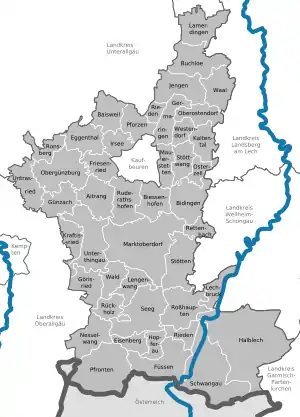Ostallgäu
Ostallgäu is a Landkreis (district) in Swabia, Bavaria, Germany. It is bounded by (from the west and clockwise) the districts of Oberallgäu, Unterallgäu, Augsburg, Landsberg, Weilheim-Schongau and Garmisch-Partenkirchen, and by the Austrian state of Tyrol. The town of Kaufbeuren is enclosed by but does not belong to the district.
Ostallgäu | |
|---|---|

| |
| Country | Germany |
| State | Bavaria |
| Adm. region | Swabia |
| Capital | Marktoberdorf |
| Area | |
| • Total | 1,395 km2 (539 sq mi) |
| Population (31 December 2019)[1] | |
| • Total | 141,182 |
| • Density | 100/km2 (260/sq mi) |
| Time zone | UTC+01:00 (CET) |
| • Summer (DST) | UTC+02:00 (CEST) |
| Vehicle registration | OAL |
| Website | http://www.ostallgaeu.de |
History
Before 1803 the region was split into several tiny states, most of them clerical states. When these states were dissolved in 1803, the Ostallgäu region became part of Bavaria. The kings of Bavaria soon developed a special relationship with the region and built their famous castles of Hohenschwangau and Neuschwanstein there.
The district was established in 1972 by merging the former districts of Kaufbeuren, Marktoberdorf and Füssen.
Geography
"Ostallgäu" literally means "Eastern Allgäu". The term Allgäu is applied to the part of the Alps located in Swabia and their northern foothills.
The district extends from the crest of the Alps to hilly countryside in the north. It is located on either side of the Wertach, an affluent of the Lech River. In the south there is a great number of alpine lakes, the largest of them being the Forggensee (16 km2 [6.2 sq mi]).
Coat of arms
 |
The coat of arms displays:
|
Towns and municipalities

| Towns | Municipalities | |
|---|---|---|
References
- "Tabellenblatt "Daten 2", Statistischer Bericht A1200C 202041 Einwohnerzahlen der Gemeinden, Kreise und Regierungsbezirke". Bayerisches Landesamt für Statistik und Datenverarbeitung (in German). July 2020.
External links
| Wikimedia Commons has media related to Landkreis Ostallgäu. |